

Ciencia y Deporte. Vol. 9. No. 3, September -December, 2024, p.e292.
Original article
Intensity, frequency and type of physical activity in adolescent schoolchildren
Intensidad, frecuencia y tipo de actividad física en escolares adolescentes
Intensidade, frequência e tipo de atividade física em adolescentes escolares
Indalecio Mujica Bermúdez1*![]() , Jaime Adrián Vargas Jerí1
, Jaime Adrián Vargas Jerí1![]()
1National University of San Cristóbal de Huamanga, Ayacucho, Peru.
*Corresponding autor: indalecio.mujica@unsch.edu.pe
Received: 29/05/2024
Approved: 09/08/2024
ABSTRACT
Introduction: Physical activity, as bodily action, requires energy consumption and is vital
for preserving bodily functions. Systematic physical activity maintains a person in a state
of homeostasis and well-being.
Objective: To identify the intensity, frequency, and type of physical activity in
adolescent schoolchildren.
Materials and Methods: Different quantitative methods were employed, using a descriptive,
cross-sectional design. The sample consisted of 1376 adolescent schoolchildren from eleven provinces
of the Ayacucho region. The Physical Activity Questionnaire for Adolescents (PAQ-A) was
applied, yielding a Cronbach's alpha of 0.807, deemed valid for the study.
Results: Data were obtained on the level of physical activity intensity during the last seven days
of the week: mean (56.7%) and during Physical Education class: mean (72.9%). Frequent
physical activity in the morning included walking to school (49.1%) and training in a sport (25.2%). In
the afternoon, the most frequent regularity was 2 times (33.1%); and in the evening was 2
times (33.4%). On weekends, the highest frequency was on Saturday (40.4%). However, 12.7%
of schoolchildren did not engage in physical activity on weekends. The most frequently
practiced collective physical activities were volleyball (18.22%), football (16.5%), and futsal
(16.20%). Individual physical activities included walking (18.20%), running (11.0%), and dance (5.5%).
Conclusions: Adolescent schoolchildren exhibited moderate-intensity physical activity, with
greater frequency in the afternoon and evening. The most frequently practiced activities were
volleyball, walking, football, and futsal. Furthermore, the recommendations of the World Health
Organization were not met.
Keywords: Physical activity, leisure activity, adolescent.
RESUMEN
Introducción: la actividad física como acción corporal requiere del consumo de energía y es vital
para preservar las funciones del organismo y su práctica sistemática mantiene a la persona en un
estado homeostático y de bienestar.
Objetivo: identificar la intensidad, la frecuencia y el tipo de actividad física en escolares adolescentes.
Materiales y métodos: se emplearon diferentes métodos, con enfoque cuantitativo, nivel
descriptivo, diseño transeccional descriptivo. La muestra conformada por 1376 escolares adolescentes de
once provincias de la región Ayacucho y se aplicó el cuestionario de actividad física PAQ-A, obteniendo
un alfa de Cronbach 0.807, válido para el estudio.
Resultados: se obtuvieron datos del nivel de intensidad de actividad física durante los últimos
siete días de la semana: media (56.7 %) y durante la clase de Educación Física: media (72.9 %). La
actividad física frecuente durante la mañana: caminar hacia el colegio (49.1 %) y entrenar algún deporte
(25.2 %). En la tarde, la frecuencia con mayor regularidad es de 2 veces (33.1 %); en la noche, 2 veces
(33.4 %). El fin de semana, la frecuencia mayor es el día sábado (40.4 %). Sin embargo, un 12.7 % de
escolares no realiza durante el fin de semana. El tipo de actividad física colectiva practicada: voleibol, (18.22
%); fútbol (16.5 %); futsal (16.20 %); actividad física individual: caminar (18.20 %); correr (11.0 %);
danza/baile (5.5 %).
Conclusiones: los adolescentes escolares presentaron actividad
física de intensidad media, con
mayor frecuencia en la tarde y noche; el tipo de actividad de mayor práctica resalta jugar voleibol,
caminar, jugar fútbol y futsal; además, no se cumple las recomendaciones de la Organización Mundial de
la Salud.
Palabras clave: actividad física, actividad de ocio, adolescente.
RESUMO
Introdução: a atividade física como ação corporal requer o consumo de energia e é vital para
preservar as funções do organismo e sua prática sistemática mantém a pessoa em estado homeostático e
de bem-estar.
Objetivo: identificar a intensidade, frequência e tipo de atividade física em adolescentes escolares.
Materiais e métodos: foram utilizados diferentes métodos, com abordagem quantitativa,
nível descritivo, delineamento descritivo transecional. A amostra foi composta por 1.376
adolescentes escolares de onze províncias da região de Ayacucho e foi aplicado o questionário de atividade
física PAQ-A, obtendo-se um alfa de Cronbach de 0,807, válido para o estudo.
Resultados: foram obtidos dados sobre o nível de intensidade de atividade física nos últimos
sete dias da semana: média (56,7 %) e durante a aula de Educação Física: média (72,9%). Atividade
física frequente pela manhã: caminhar até a escola (49,1 %) e praticar algum esporte (25,2 %). À tarde,
a frequência com maior regularidade é de 2 vezes (33,1 %); à noite, 2 vezes (33,4%). No final de
semana, a maior frequência é o sábado (40,4%). Porém, 12,7% dos escolares não trabalham no final de
semana. O tipo de atividade física coletiva praticada: voleibol, (18,22 %); futebol (16,5 %); futsal (16,20
%); atividade física individual: caminhada (18,20 %); corrida (11,0%); dança/dança (5,5 %).
Conclusões: os adolescentes escolares apresentaram atividade física de média intensidade, com
maior frequência nos períodos vespertino e noturno; O tipo de atividade mais praticada destaca jogar
vôlei, caminhar, jogar futebol e futsal; Além disso, as recomendações da Organização Mundial da
Saúde não são cumpridas.
Palavras-chave: atividade física, atividade de lazer, adolescente.
INTRODUCTION
The current global landscape, particularly affecting children and adolescents, is facing a complex set of challenges. These include climate change, environmental pollution, social media misinformation, harmful commercial marketing, unhealthy eating habits, social violence, migration, inequality, and sedentary lifestyles due to the indiscriminate use of technology. While the education and nutrition of children and adolescents have improved in many countries over the last decade, indicators of health and well-being in childhood and adolescence, as measured against the Sustainable Development Goals (SDGs), have not shown positive progress (WHO: descriptive notes, November 19, 2020).
Over the past decade, an increasing number of studies have demonstrated that consistent physical activity is a crucial factor in improving overall health. For over 40 years, the WHO has promoted and recommended the importance of physical activity as a protector of physical well-being, mental processes, social interaction, and emotional regulation, even for academic learning (WHO, 2021).
Scientific evidence shows a growing adoption of sedentary lifestyles among children and adolescents, with consequent implications for their physical, mental, and emotional health in later stages of life (WHO, 2021). The Pan American Health Organization (PAHO, 2019) indicates that 81% of adolescents aged 11 to 17 years do not adhere to the WHO's global recommendations for physical activity. The responsibility lies with the governments of each country that do not promote public policies that endorse the importance of this form of physical culture.
The WHO (2020) recommends that children and adolescents aged 5 to 17 years should engage in at least 60 minutes of moderate-to-vigorous-intensity physical activity on at least 3 days per week. However, three out of four adolescents aged 11 to 17 years currently do not meet this recommendation. It also notes that as the economic development of countries increases, so does the number of sedentary individuals.
In Peru, a report from the Nutritional Indicators Surveillance using data from the National Household Survey conducted by the National Center for Food and Nutrition (MINSA by its acronym in Spanish, 2021) shows that four out of five Peruvians only perform light physical activity, which is equivalent to a sedentary lifestyle. The Ministry of Health (MINSA, 2020) published a technical report on physical activity in Peruvian adults aged 18 to 59 years, based on data collected between 2017 and 2018. The results show that nationally, 61.9 % of respondents had low levels of physical activity. Low physical activity was higher among women (66.0 %). Moderate physical activity was more frequent in rural areas (49.3%).
In the region of Ayacucho, there is no evidence of extensive research reporting on physical activity levels in the school-aged population. One study by Cuárez and Eyzaguirre (2021) reported results indicating 28% (56 students) with sedentary behavior, 58 % (116 students) at a moderately active level, and 14% (29 students) at a very active level. The study concluded that there is a low level of physical activity among elementary school students in three flagship educational institutions in the district of Ayacucho. There is no scientific information on the progress suggested by the WHO regarding physical activity in the adolescent population and its social, educational, and health implications in the Ayacucho region.
The World Health Organization (WHO, 2022) defines physical activity as "any bodily movement produced by skeletal muscles that results in energy expenditure. Physical activity refers to all movement […]" (WHO: fact sheets, October 5, 2022).
A widely cited definition is that of Caspersen, Powell, and Cristenson (1985), who consider it as "any bodily movement produced by skeletal muscles that result in energy expenditure above basal metabolic rate" (p. 126). De Abajo and Márquez (2013) emphasize that physical activity is the energy used for bodily movement it is the added energy consumption the body requires maintaining vital functions such as breathing, digestion, and blood circulation, among others.
From the perspective of self-perception or corporeality, according to Vidarte et al. (2011), physical activity is that experience consciously expressed in awareness of the self and its body in action; it seeks opportunities for movement expression to generate positive attitudes towards life. The authors' focus is on understanding that every human action is emergent intentionality that generates transcendence towards personal improvement, based on internalizing positive experiences that give meaning to life in the conception of emotional embodiment.
The two perspectives of physical activity as preventive-therapeutic (WHO, 2021) and personal-environmental experience (Vidarte et al., 2011) lead to a perspective of greater personal grounding: the perspective of physical activity as embodied experience based on human motor skills (Sérgio, 2006). This perspective takes into account the previous two, that is, physical activity for personal health, physical activity from a social and cultural context, and physical activity as a personalized experience and permanent self-construction to find personal, social, emotional, and mental well-being that benefits all dimensions of being human
Physical activity is measurable through various procedures, the most common being the monitoring of the intensity or exertion the body displays during a specific physical activity. This presents two dimensions for analysis: first, what is physical intensity or exertion; and second, what characteristics does this intensity possess to be measured and categorized into levels. Intensity, in general terms, is the "degree of force with which a natural agent, a physical magnitude, a quality, an expression, etc., manifests itself" (RAE, 2023). It is also defined as "the degree of physical energy expended by a person" or "the amount of work being done or the magnitude of effort required to perform an activity or exercise" (Servidor-alicante, 2023). It is a qualitative effort that manifests itself with changes in respiration, heart rate, and muscle strength exerted during the activity. Intensity presents subjective variations in each person because the perceived exertion differs, especially depending on experience, frequency, and physical condition; therefore, the perceived level of exertion can be different from one person to another when performing the same activity.
The intensity of a physical activity is conditioned by a set of factors such as the type of activity, the type of muscle contraction and force involved the speed of the action, the time and rhythm of the action, and the rest interval. Likewise, factors related to execution such as age, frequency of practice, execution time, motivational and emotional conditions, and above all, the environmental context are influential. Martínez et al. (2009) point out that the intensity of an activity could manifest different levels of exertion in two people of the same age; even the exertion experienced during an activity varies from one day to the next, influenced by the time of day the activity is performed (morning, afternoon, or night). Therefore, a way to identify the intensity of physical work should be measured personally with respect to its functional response.
Ribeiro and Mota (2014) indicate that, to measure physical activity, objective and subjective procedures are currently available. Objective assessment is based exclusively on physiological evidence, such as energy consumption or physical exertion; for this, laboratory techniques or external devices are used. These techniques include direct or indirect calorimetry, heart rate monitors, pedometers, accelerometers, among others. These are useful for measuring one or a few people; however, for larger populations, the cost is high, and the time required to obtain results is long. Currently, pedometers and accelerometers are frequently used and their cost is accessible for everyday use; however, measuring large samples remains costly.
Subjective procedures are based on survey techniques, observation, self-reports, and interviews; they also use validated questionnaires, administered or self-administered, physical activity diaries, interview questionnaires, among others that have been validated and recognized by the WHO, such as the IPAQ and the PAQ-A in different versions for schoolchildren and adults. Through questionnaires, personal perceptions, opinions, experiences, or the way in which the intensity of the physical activity performed has been manifested are evidenced. The cost and time of application are minimal, but there is a possibility of bias in the reliability and validity of the content and results, generating low precision in the data that can be collected regarding the intensity of physical activity performed. The choice between objective or subjective techniques depends on the research objectives, the representative sample, the methodological design, and above all, the honesty of the data collected (Ribeiro and Mota, 2014).
The levels of physical activity based on the "talk test," as established by studies conducted by the Centers for Disease Control and Prevention (CDC) in the United States, present the following intensity levels: a) low or light: the individual can speak easily and continuously while performing the activity (less than 50% of maximum heart rate). There is minimal sweating and postural control; b) moderate: the individual can talk but cannot maintain a fluid conversation because they need to pause to catch their breath; they can talk but cannot sing during the activity. The approximate heart rate is 70 %. There is regular sweating and control of body balance, c) high or vigorous: the individual can say only a few words without pausing to breathe. The heart rate is above 70 %. There is excessive sweating, muscular incoordination, and a sensation of loss of body balance.
Rojas et al. (2020) propose levels of physical activity based on the association between the "talk test" and energy expenditure in METs. Which are as follows: a) low or light intensity: when a person engages in physical activity that allows them to converse fluently without interrupting the activity they are performing, does not accelerate heart rate, and does not show significant sweating. It involves an approximate energy expenditure of less than 3.3 METs. b) Moderate intensity: when a person engages in physical activity that requires more than normal breathing but does not affect their ability to converse, increases heart rate, and the required energy expenditure ranges from 4-8 METs. c) Vigorous intensity: when a person engages in physical activity that makes fluid conversation difficult; it requires obtaining a large part of energy from anaerobic sources and generates metabolic work above the anaerobic threshold. There is an acceleration of the pulse above 85% of maximum heart rate, with energy expenditure greater than 8.0 METs.
The reasons that motivate the development of the research are supported by: on one hand, most countries around the world do not meet WHO (2019) recommendations to reduce high levels of sedentary behavior among children and adolescents (81% of students aged 11 to 17 years). On the other hand, there is a lack of evidence from extensive studies on levels of physical activity among Peruvian adolescent students; likewise, there is no evidence of large-scale studies in the Ayacucho region.
The objective of this research is to identify the levels of physical activity among adolescent students in the Ayacucho region. Specifically, it aims to measure the intensity of weekly physical activity and during physical education classes, the frequency of weekly physical activity practice, and the types of frequent physical activities. The results will serve to propose, through other experimental studies, motor skills programs that promote self-awareness and the cultivation of habits related to physical activity as a preventive mechanism and holistic health approach for adolescent students.
MATERIALS AND METHODS
The study adopted a quantitative approach, classified as basic due to its theoretical contribution for a better understanding of social phenomena (physical activity practice) in their context and natural reality. The level of research was non-experimental descriptive, "known as statistical research, which describes the data and characteristics of the population or phenomenon under study as they are. Its central objective is the description of phenomena." During the study, a statistical method was employed, collecting and organizing data derived from surveys related to certain characteristics associated with the dimensions of the study. A cross-sectional descriptive design was used to differentiate groups, which is defined as "in these cases, the researcher seeks to describe variables and/or establish differences between groups at a single point in time." (p. 75). This design allowed for the collection of data from students in various cultural contexts, ages, and educational levels across eleven provinces in the Ayacucho region.
Participants
The population consisted of 12,031 secondary education students from eleven provinces in the Ayacucho region. The sample included 1,376 (11.44 %) students from the 3rd, 4th, and 5th grades of secondary education from 11 representative educational institutions in each of the eleven provinces of the Ayacucho region (Table 1).
Table 1. - Sample of surveyed students
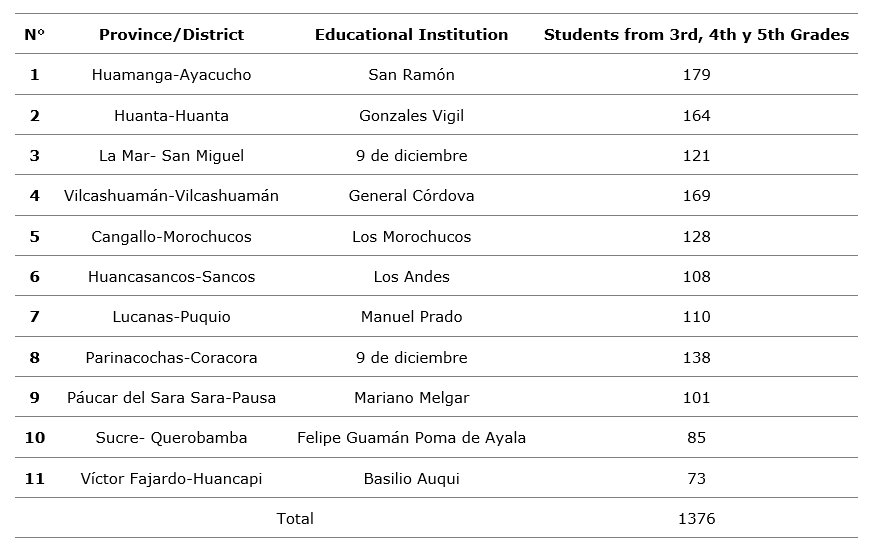
Source: Escale. Minedu-2022.
Instrument
The Physical Activity Questionnaire for Adolescents (PAQ-A) was used to assess the physical activity of adolescents in Canada and endorsed by the WHO for application in other countries. It measures levels of physical activity over the past seven days in activities performed by students, applicable for ages 13 to 18. The questionnaire consists of nine questions that evaluate different aspects of the physical activity carried out by the student at various times during the day.
The instrument was adapted taking into account another study, based on the socio-cultural physical activities of students in the Ayacucho region. The interpretation of the levels of physical activity was based on the speech test from the U.S. Department of Health and Human Services (Centers for Disease Control and Prevention). Question 1 was modified to reflect the types of physical activity according to the context of the study; question 7 was eliminated as it was deemed repetitive of previous questions and could confuse respondents. A pilot test was conducted with 169 students from, the 3rd, 4th, and 5th grades of secondary education who were not part of the study sample. The Cronbach's alpha reliability reached a value of 0.807, which is considered "Good."
The research was conducted from June to September (data collection from the sample) in 2022, and the survey was administered in the classroom of each educational institution.
RESULTS AND DISCUSSION
The descriptive results of the physical activity practiced by schoolchildren in the Ayacucho region are presented in three dimensions:
Dimension 1. Intensity
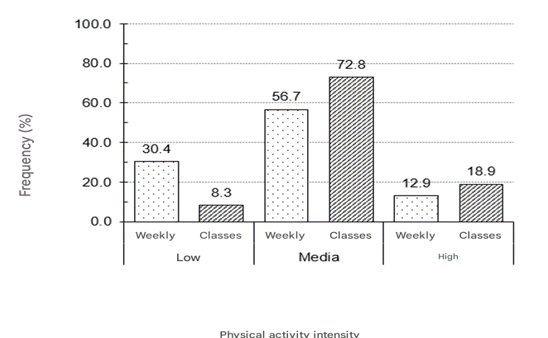
Fig. 1. - Comparison: intensity of physical activity during the seven days of the week and during
physical education class in schoolchildren from the Ayacucho region.
Figure 1 shows that the comparison between the level of intensity of physical activity in both contexts was of moderate intensity, with 56.7 % (over the course of the seven days of the week) and 72.8 % (during physical education class) practiced by schoolchildren from the Ayacucho region (Figure 1).
Dimension 2. Frequency
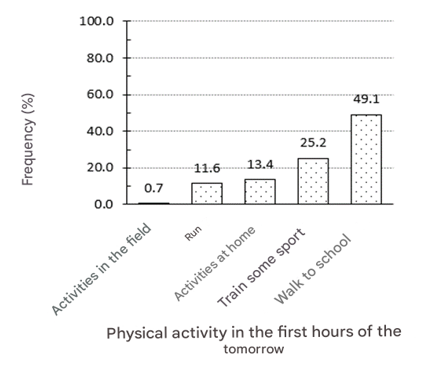
Fig. 2. - Comparison: types of activity and frequency during the early hours of the morning
among schoolchildren in the Ayacucho region
Figure 2 shows that walking to school (49.1 %) is the most frequently practiced physical activity during the early hours of the morning by schoolchildren in the Ayacucho region (Figure 2).
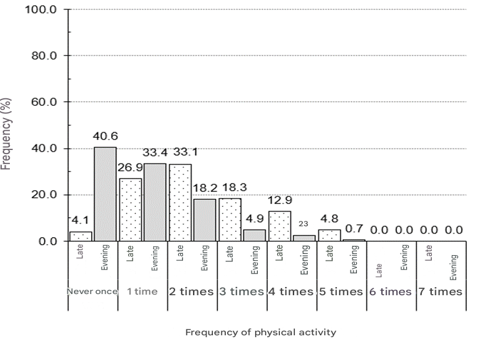
Fig. 3. - Comparison: frequency of physical activity during the afternoon and evening
among schoolchildren in the Ayacucho region
Figure 3 shows that the frequency of physical activity practiced most regularly is 2, 1, and 3 times during the afternoon, with percentages of (33.1 %; 26.1 %; 18.2 %) respectively, and 2 times during the evening (33.4 %; 18.2 % respectively). However, 40.6% of schoolchildren do not engage in physical activity during the evening. Additionally, no schoolchildren reported practicing physical activity between six and seven times a week during the afternoon or evening (Figure 3).
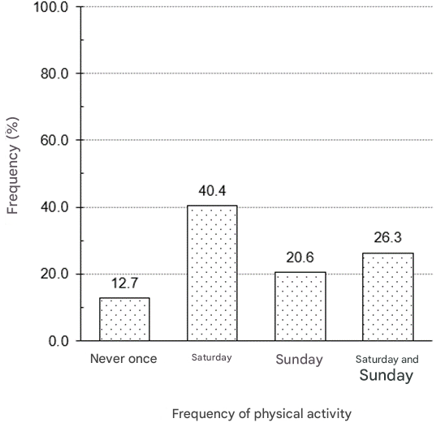
Fig. 4. - Comparison: Frequency of physical activity on Saturdays and Sundays in schoolchildren
from the Ayacucho region.
Figure 4. shows that Saturday is the most frequent day for physical activity (40.4%). However, 12.7 % of schoolchildren do not engage in physical activity during the weekend (Figure 4).
Dimension 3. TYPE
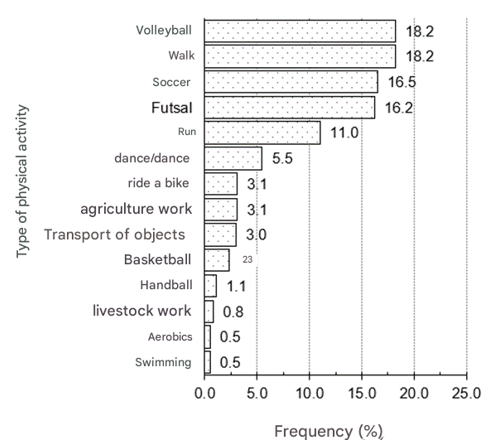
Fig. 5. - Most Frequent Type of Physical Activity Practiced in the Last Seven Days by
Schoolchildren in the Ayacucho Region
Figure 5 shows that the most frequent team sports practiced are volleyball, soccer, and futsal, while the most frequent individual physical activities are walking, running, and dancing/ballet (Figure 5).
The results regarding physical activity intensity show that, over the last seven days, students exhibited low intensity 30.4%, medium intensity 56.7%, and high intensity 12.9%. During Physical Education class, however, the distribution was low intensity 8.3%, medium intensity 72.9%, and high intensity 18.9%. Comparing this to other research, Rodríguez et al. (2020) demonstrated that, analyzing 40 scientific documents, 34% of Ecuadorian adolescents (10-17 years old) are inactive, 38.1% are irregularly active, and less than three out of ten are active. It could be deduced that there is a recurrence of physical inactivity and persistent sedentary behavior, increasing as the age of schoolchildren increases, similar to our results. This similarity could be explained by the fact that students in the 5th year of secondary school tend to practice less physical activity due to dedicating time to other academic activities in preparation for university or higher education applications; also, due to the appeal of socializing with friends, physical activity may temporarily become less important. However, a group finds in physical activity a space for social interaction and a way to communicate their physical condition to others. A different contribution is that of Mateo-Orcajada et al. (2021), who found that the frequency and duration of physical activity practice in schoolchildren were determined by their parents. These findings are important for understanding the extent to which the family environment conditions the promotion of physical activity in schoolchildren. Culturally, in the study context, no information has been reported on this aspect; it could be a subject for future study.
Comparing this study with Portela and Vidarte (2019), who evidenced low to moderate levels of physical activity in a Colombian school population due to frequent television viewing, computer use, and time spent on video games; the context described here shows a similar low to moderate trend. It is important to emphasize that the experiences of schoolchildren in Ayacucho, Peru, do not differ from the context of the population of Popayán, Colombia; most of the surveyed schoolchildren have a mobile device that they use for a large part of the day, frequently using it for up to six hours (Morales et al., 2016).
In Peru, studies conducted on 4th and 5th-grade secondary school students in Puno (Mamani et al., 2017; Mamani, 2019) found that the level of physical activity was moderate to low; it could be established that the practice of physical activity does not meet the levels recommended by the WHO (2021). While Morales et al. (2016) showed that adolescents exhibited a high level of physical activity in 59% and moderate to low levels in 41%. The aforementioned studies show that the practice of physical activity in a part of the Peruvian school population has not improved substantially, and the irrelevance of physical activity to lifestyle habits is perceived.
The National Curriculum for Basic Education (MINEDU by its acronym in Spanish, 2016) mandates that secondary school students must learn the competency "Assumes a healthy life"; this implies improving their quality of life (physical activity, proper body posture, healthy eating, and personal and environmental hygiene, based on the sociocultural and environmental context). However, factors contributing to the low and moderate levels of physical activity in physical education classes include the practice time (80 minutes per week). In this sense, in physical education classes, the trend is from moderate to low; it can be inferred that physical activity, as an inherent part of being human, is not a proactive element in schoolchildren in the Ayacucho region; some sports imply higher intensity than others do.
A retrospective and prospective comparison, which cannot be generalized and could support a long-term outlook, is the study by Rodríguez-Fernández, et al. (2021). They concluded that 68.65% of Cuban university students presented a low level of physical activity, based on hypotheses of physical activity habits stemming from their school experiences and the prioritization of cognitive academic activity over physical activity. These assertions have implications for the habits and customs of schoolchildren linked to previous experiences and could be predictors of social behaviors in students throughout their school, university, and professional careers.
The results regarding physical activity frequency over the last seven days show that, during the early morning hours, the most frequent activities are walking and participating in sports. Other activities include household chores, running, and fieldwork. In the afternoons, participants engaged in physical activity an average of twice. Physical activity decreased substantially in the evenings. During weekends, Saturday was the preferred day for physical activity.
Comparing our study's results with those of Rodríguez et al. (2021), a representative sample of Spanish schoolchildren showed that 86.4% engaged in physical activity outside of school, with boys being more active than girls are. Marambio et al. (2020) showed levels of physical activity inside and outside school in Chilean schoolchildren, where girls were more active than boys; similarly, Saturdays showed the highest frequency of physical activity among schoolchildren. This comparison suggests that during morning hours, little physical activity is undertaken, with those hours dedicated to academic-cognitive activities; afternoons are when a larger group of students dedicates two to three days, primarily, to sports training or recreational sports. Saturday is the day with the highest frequency of activity.
The recommendations of the WHO (2021) and the Pan American Health Organization (PAHO, 2019) are not met by the adolescents participating in the various studies in terms of frequency and intensity of activity, with a predominantly moderate-to-low level. Factors such as older age, being female, having a low-to-middle socioeconomic status, living in environments unfavorable for physical activity, not participating in extracurricular sports, and body image dissatisfaction are predictors of low levels of physical activity (Jiménez et al., 2021); however, a positive association was reported with quality of life, self-esteem, nighttime sleep hours, and maximum oxygen consumption.
The results regarding the types of physical activity practiced over the last seven days showed a preference for team sports: volleyball, soccer, and futsal; and for individual activities: walking, running, and dancing. These practices show similarities to a sample of Chilean schoolchildren, where girls prefer dance and boys prefer soccer (Marambio et al., 2020).
The team physical activities of adolescent schoolchildren are recreational in nature; therefore, they showed moderate intensity. Individual activities like running, requiring greater physical exertion, showed moderate to vigorous intensity. Therefore, the type of physical activity could be considered a predictor of health and physical well-being. The multiple bodily manifestations that exist in today's society contribute positive benefits to physical health (prevention and treatment of diseases) and mental health (regulation of problems associated with depression, anxiety, dementia, etc.). As well as, social health (increased communication and empathy with others), emotional health (control and expression of positive attitudes through emotional regulation), and academic performance (contributes to increased blood flow to the brain and production of hormones that help improve attention and memory).
The habitual practice of physical activity produces somatic energy that regulates the balance between the brain and posture; Mantovani et al. (2021) highlight the relevance of physical activity to health; however, in school settings, health remains an area needing further attention.
The strength of the research lies in the participation of a sample of 1376 (11.44%) schoolchildren from a population of over 12,000, representing eleven provinces of the Ayacucho region. Despite not measuring and comparing the sex variable, the type of physical activity was included as an approximation to this variable, and the type of activity can suggest the corresponding preference. Future research could stem from this investigation, focusing on physical activity in schoolchildren. Including sedentary behavioral traits in the school population, the causes of physical inactivity in schoolchildren, proposals for systemic intervention strategies to generate habits of physical activity, especially in schoolchildren who are not motivated towards these practices and studies related to the use of technological physical activity trackers and digital resources over time in sedentary schoolchildren (Verswijveren et al., 2022). These thematic axes could shed light on the problem of physical inactivity in the school population.
CONCLUSIONS
The study's findings and comparison with other research demonstrate that the World Health Organization's recommendations regarding the frequency and intensity of physical activity in school-aged adolescents are not being met. The brain learns to regulate the body when it becomes accustomed to a specific physical activity. Regular physical activity offers substantial bodily changes, such as improved physical condition, increased cardiovascular capacity, muscle strengthening, enhanced complex skills, and other benefits.
BIBLIOGRAPHIC REFERENCES
Caspersen, C., Powell, K., y Christenson, G. (1985). Physical activity, exercise, and physical fitness: Definitions and distintions for health-related research. Public Health Reports, 100(2), 126-131. https://pmc.ncbi.nlm.nih.gov/articles/PMC1424733/
De Abajo, S. y Márquez, S. (2013). Actividad física y salud. En Márquez, N. y Garatachea, N. Actividad física y Salud. Ediciones Díaz de Santos, S.A Libro electrónico. FUNIBER. https://www.academia.edu/41615733/ACTIVIDAD_F%C3%8DSICA_Y_SALUD
Jiménez Boraita, R., Gargallo Ibort, E., Dalmau Torres, J. M. y Arriscado Alsina, D. (2022). Factores asociados a un bajo nivel de actividad física en adolescentes de la Rioja (España), Anales de Pediatría, 96, (4), 2022, Pages 326-333, ISSN 1695-4033, https://www.analesdepediatria.org/es-factores-asociados-un-bajo-nivel-articulo-S1695403321001442
Mamani, A.A.; Fuentes, J.D.; Machaca, J.E. (2017). Actividad física en adolescentes https://doi.org/10.1016/j.anpedi.2021.02.011.escolares de la ciudad de Puno. Sportis Sci J, 3 (3), 525-541. DOI: https://doi.org/10.17979/sportis.2017.3.3.2015
Mamani, R. (2019). Actividad física en estudiantes del séptimo ciclo de la institución educativa secundaria Miguel Grau del distrito de Amantani Puno 2019. Tesis de pregrado. Universidad Nacional del Altiplano. Puno. http://repositorio.unap.edu.pe/handle/UNAP/13145
Mantovani, Thiago Villa Lobos; MALDONADO, Daniel Teixeira; FREIRE, Elisabete dos Santos. A relação entre saúde e educação física escolar: uma revisão integrativa. Movimento (Porto Alegre), v.27, p. e27008, jan./dez. 2021. https://doi.org/10.22456/1982-8918.106792
Marambio Miranda, M., Núñez Fernández, T., Ramírez Guajardo, J., Ramírez Eyraud, P., Palma Leal, X. A., & Rodríguez-Rodríguez., F. (2020). Relación entre la actividad física escolar y extraescolar en estudiantes de escuelas públicas chilenas. Retos, 37, 393-399. https://doi.org/10.47197/retos.v37i37.72851
Martínez-Gómez D., Martínez-de-Haro, V., Pozo, T.; Welk, G.; Villagra, A; Calle, M.; Marcos, A. & Veiga, O. (2009). Fiabilidad y validez del cuestionario de actividad física PAQ-A en adolescentes españoles. Rev. Esp. Salud Publica [Internet]. 2009 Jun; 83( 3 ): 427-439. http://scielo.isciii.es/scielo.php?script=sci_arttext&pid=S1135-57272009000300008&lng=es .
Mateo-Orcajada, Adrián; et al. Influencia del género, nivel educativo y práctica deportiva parentales sobre hábitos deportivos en escolares. Movimento (Porto Alegre), v. 27, e27057, ene./dic. 2021. https://doi.org/10.22456/1982-8918.109610
Morales Quispe, Juan, Añez Ramos, Roberto Jose, & Suarez Oré, Cesar Abraham. (2016). Nivel de actividad física en adolescentes de un distrito de la región Callao. Revista Peruana de Medicina Experimental y Salud Publica, 33(3), 471-477. https://dx.doi.org/10.17843/rpmesp.2016.333.2312
OMS (2021). Directrices de la OMS sobre actividad física y comportamientos sedentarios. ISBN 978-92-4-003219-4 (versión electrónica). https://www.who.int/es/publications/i/item/9789240014886
OPS (2019). Plan de acción mundial sobre actividad física 2018-2030. Más personas activas para un mundo sano. Washington, D.C.: Organización Panamericana de la Salud; 2019. Licencia: CC BY-NC-SA 3.0 IGO. https://iris.paho.org/bitstream/handle/10665.2/50904/9789275320600_spa.pdf
Portela-García, C.A. y Vidarte-Claros, A. (2021). Niveles de actividad física y gasto frente a pantallas en escolares: diferencias de edad y género. Univ. Salud. 2021;23(3):189-197. DOI: https://doi.org/10.22267/rus.212303.232
Ribeiro, J. y Mota, J. (2014). Métodos de investigación en actividad física: de la evaluación a la intervención. En Promoción de la actividad física en la infancia y la adolescencia. Generelo, E.; Zaragaza, J.; Julián, J. (2014). [Coords.]. Madrid. Imprenta Nacional del BOE.
Rodríguez-Fernández, J. E., Rico-Díaz, J., Neira-Martín, P. J., & Navarro-Patón, R. (2021). Actividad física realizada por escolares españoles según edad y género (Physical activity carried out by Spanish schoolchildren according to age and gender). Retos, 39, 238-245. https://doi.org/10.47197/retos.v0i39.77252
Rodríguez-Rodríguez, J., y Reguant-Álvarez, M. (2020). Calcular la fiabilidad de un cuestionario o escala mediante el SPSS: el coeficiente alfa de Cronbach. REIRE Revista d'Innovació i Recerca en Educació, 13(2), 113. https://doi.org/10.1344/reire2020.13.230048
Rojas, L. D; Rodríguez, I.; Rodríguez, K; Espinoza, I.; González, C.; Sacerio, I. & Angulo, C. M. (2020). Niveles de actividad física en estudiantes de enfermería. Revista Finlay, 10(4), 420-427. Epub 30 de diciembre de 2020. http://scielo.sld.cu/scielo.php?script=sci_arttext&pid=S222124342020000400420&lng=es&tlng=es.
Sérgio, M. (2006). Motricidad Humana, ¿cuál es el futuro? Pensamiento Educativo, Revista De Investigación Latinoamericana (PEL), 38(1), 14-33. https://redae.uc.cl/index.php/pel/article/view/23935
Verswijveren, S. J. J. M., Abbott, G., Lai, S. K., Salmon, J., Timperio, A., Brown, H., Macfarlane, S., & Ridgers, N. D. (2022). Mediators of Effects on Physical Activity and Sedentary Time in an Activity Tracker and Behavior Change Intervention for Adolescents: Secondary Analysis of a Cluster Randomized Controlled Trial. JMIR mHealth and uHealth, 10(8), e35261. https://doi.org/10.2196/35261
Vidarte, J. A.; Vélez, C.; Sandoval, C. & Alfonso M. L. (2011). Actividad física: estrategia de promoción de la salud. Hacia la Promoción de la Salud, 16, (1), enero - junio 2011, págs. 202 218. http://www.scielo.org.co/pdf/hpsal/v16n1/v16n1a14.pdf
Conflict of interest statement:
The authors declare having competing interests.
Author contribution statement:
The authors have participated in the redaction of the manuscript and the documentary review.
![]()
This paper is distributed under the terms of the Licencia CreativeCommons (CC) 4.0. (CC BY-NC-SA 4.0)
Copyright (c) 2024
ndalecio Mujica Bermúdez, Jaime Adrián Vargas Jerí